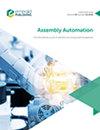A novel event-triggered adaptive tracking control framework for a manipulator with aperiodic neural network estimation
IF 1.7
4区 计算机科学
Q3 AUTOMATION & CONTROL SYSTEMS
引用次数: 1
Abstract
Purpose The purpose of this study is developing the minimum parameter learning law for the weight updating, which reduces the updating of neural network (NN) weight only at triggering instants and makes a trade-off between the estimation accuracy and triggering frequency such that the computing complexity can be decreased. Besides that, a novel “soft” method is first constructed for the control updating at the triggered instants, to reduce the chattering effect of discontinued renewal of control. Addressing to the proposed control and updating method, a novel dead-zone condition with variable boundary about the triggered control signal is derived to ensure the positivity of adjacent execution intervals. Design/methodology/approach In this paper, to achieve the motion tracking of manipulator with uncertainty of system dynamics and the communication constraints in the control-execution channel, an adaptive event-triggered controller with NN identification is constructed to improve the transmission efficiency of control on the premise of the guaranteed performance. In the proposed method, the NN with intermittent updating is proposed to perform the uncertain approximation with the saved computation, and the triggered mechanism is constructed to regulate the transportation of the signal in the channel of controller-to-actuator. Findings According to the impulsive Lyapunov function, it can be proved that all the signals are semi-global uniformly ultimately bounded, and the positivity of adjacent execution intervals is also guaranteed by the proposed method. In addition, the chattering effect of control updating at the jumping instants can be relieved by the proposed “soft” mechanism, such that the control accuracy and stability can be guaranteed. Experiments on the JACO2 real manipulator are carried out to verify the effectiveness of the proposed scheme. Originality/value To the best of the author’s knowledge, this study is firstly to propose a “soft” method to reduce the chattering effect caused by discontinuous updating. Addressing to the updating method designed above, a novel dead-zone condition with variable threshold and boundary is first constructed to ensure the positivity of execution intervals.基于非周期神经网络估计的机械臂事件触发自适应跟踪控制框架
本研究的目的是建立最小参数学习规律,使神经网络的权值更新只在触发时刻进行,并在估计精度和触发频率之间进行权衡,从而降低计算复杂度。此外,首先构造了一种新的“软”方法,用于在触发时刻更新控制,以减少控制更新中断带来的抖振效应。针对所提出的控制和更新方法,推导了一种新的控制信号触发的可变边界死区条件,以保证相邻执行间隔的正性。为实现具有系统动力学不确定性和控制执行通道通信约束的机械臂的运动跟踪,构造了一种带有神经网络识别的自适应事件触发控制器,在保证性能的前提下提高控制的传递效率。该方法利用间歇性更新的神经网络在节省计算量的情况下进行不确定逼近,并构建触发机制调节信号在控制器到执行器通道中的传输。根据脉冲Lyapunov函数,证明了所有信号都是半全局一致最终有界的,并保证了相邻执行间隔的正性。此外,所提出的“软”机制可以缓解控制更新在跳变时刻的抖振效应,从而保证控制的精度和稳定性。在JACO2实体机械手上进行了实验,验证了所提方案的有效性。原创性/价值据作者所知,本研究首次提出了一种“软”方法来降低不连续更新带来的抖振效应。针对上述设计的更新方法,首先构造了一种新的具有可变阈值和边界的死区条件,以保证执行间隔的正性;
本文章由计算机程序翻译,如有差异,请以英文原文为准。
求助全文
约1分钟内获得全文
求助全文
来源期刊

Assembly Automation
工程技术-工程:制造
CiteScore
4.30
自引率
14.30%
发文量
51
审稿时长
3.3 months
期刊介绍:
Assembly Automation publishes peer reviewed research articles, technology reviews and specially commissioned case studies. Each issue includes high quality content covering all aspects of assembly technology and automation, and reflecting the most interesting and strategically important research and development activities from around the world. Because of this, readers can stay at the very forefront of industry developments.
All research articles undergo rigorous double-blind peer review, and the journal’s policy of not publishing work that has only been tested in simulation means that only the very best and most practical research articles are included. This ensures that the material that is published has real relevance and value for commercial manufacturing and research organizations.
 求助内容:
求助内容: 应助结果提醒方式:
应助结果提醒方式:


